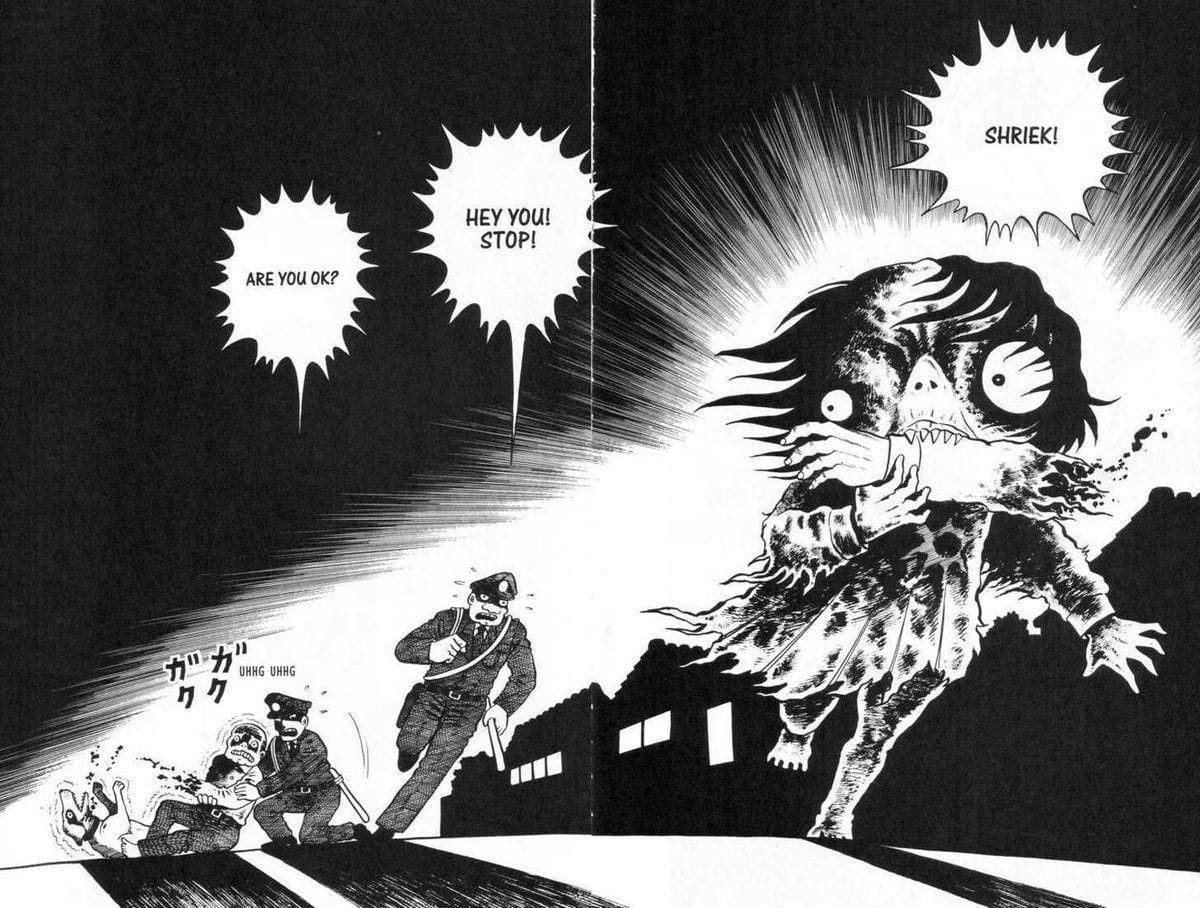Table of contents
- Kazuo Umezu ( The Drifting Classroom , Orochi , Fourteen )
- Hideshi Hino (The Bug Boy, Hell Baby, Gallery Of Horrors)
- Shigeru Mizuki ( GeGeGe No Kitaro )
- Shintaro Kago ( Super Dimensional Love Gun , Dimension 21 )
- Masaaki Nakayama ( PTSD Radio , Fuan No Tane )
- Suehiro Maruo ( The Strange Tale Of Panorama Island , Shojo Tsubaki )
- Kanako Inuki ( Be Very Afraid Of Kanako Inuki! , School Zone , Presents )
- Shuzo Oshimi ( Blood On The Tracks , Flowers Of Evil )
- In Conclusion
- Works Cited
“During the whole of a dull, dark, and soundless day in the autumn of the year, when the clouds hung oppressively low in the heavens…”
– Edgar Allen Poe, The Fall Of The House Of Usher
The sky is blue, the grass is green, and Junji Ito is the world’s biggest horror mangaka. From terrifying tales like the spiraling megahit Uzumaki to the downright haunting Tomie, Ito boasts an incredible catalogue of suspenseful tales meant to stand your spine’s hair on end. But for those who have read his works, where else do you turn to? Contrary to ultra-popular battle shonen anime, for example. there’s not a clear direction to go! Many good-naturedly point you in the direction of Tokyo Ghoul, Attack On Titan, or Berserk, though this misinterprets horror elements within a series as horror-genre stories proper.
Though they try their best, they aren’t going to scratch the same itch as a tale from the crypt. There are a lot of artists out there, though, and keeping them hidden isn’t going to do us any good! You’ve certainly heard of pieces like The Drifting Classroom, but have you ever been afraid of Kanako Inuki’s works? How does it feel to be a bug boy, or a hell baby? Have you ever stepped onto an island of impossibility? Been surrounded by malevolent spirits on all sides? All these tales and more lie in wait, just for you…
Kazuo Umezu (The Drifting Classroom, Orochi, Fourteen)
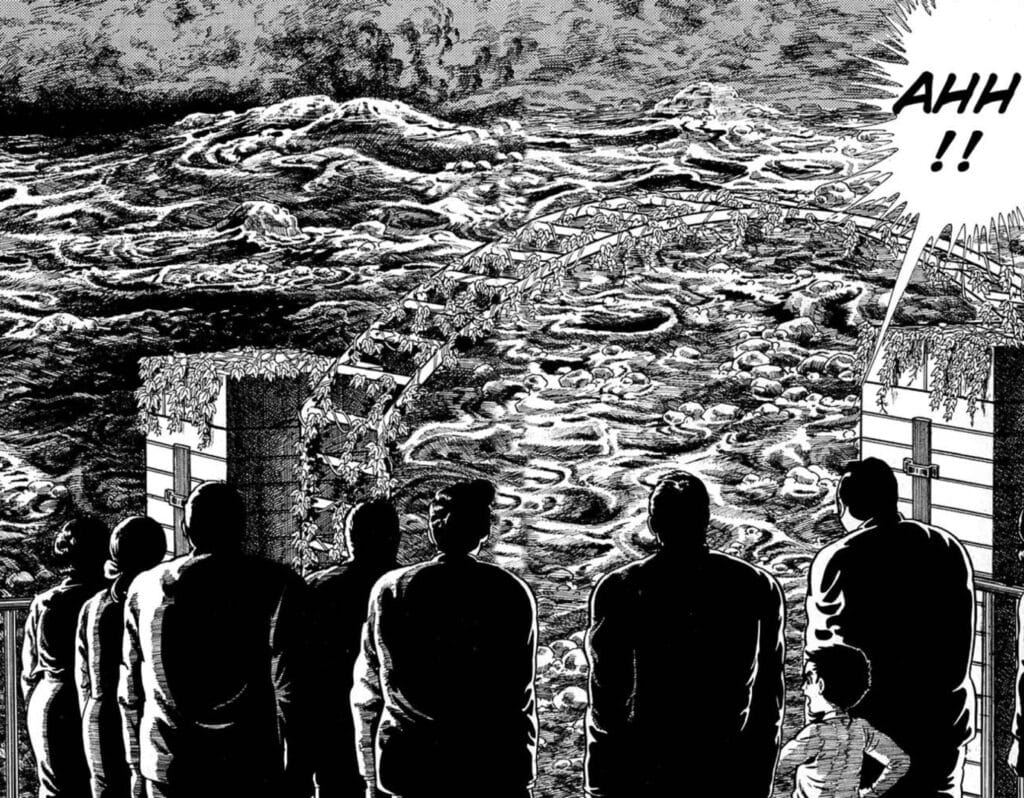

You can’t mention Junji Ito without mentioning his greatest influence. In an interview with online magazine Retrofuturista, Ito said “I’ve always been interested in scary stories and films from a very young age. I believe the reason behind this was Kazuo Umezu’s influence” (Musorrafiti), and it shows! With beautifully detailed, scratchy linework and bold character designs, Kazuo Umezu knows how to paint a scene, and more importantly, how to make it utterly bone-chilling. In his seminal work The Drifting Classroom, an entire school is pulled out of its spot on Earth, and plopped back into a place entirely alien, with dangerous threats and terrifying revelations awaiting every turn.
Like Lord Of The Flies on horror-jumped steroids, Umezu not only explores the messed-up worlds he creates, but dissects them, examining them through characters and their reactions, how they clash with one another, and how they confront the horrors that await them. Ito was influenced by very clear things here: A defined mystery, an emphasis on character reactions to the grotesque, and an evolving situation that seems to spiral (get it?) out of control. If you’re looking for Drifting Classroom, you’re in luck – There’s a recent release of chunky hardcovers you can find at your local book retailer, or some out-of-print single volumes if you’re feeling fancy. Make sure to check out some of Umezu’s other work too, like Orochi, My Name Is Shingo, and Fourteen – he’s got some absolutely ridiculous concepts that he unfolds to utter perfection!
Hideshi Hino (The Bug Boy, Hell Baby, Gallery Of Horrors)
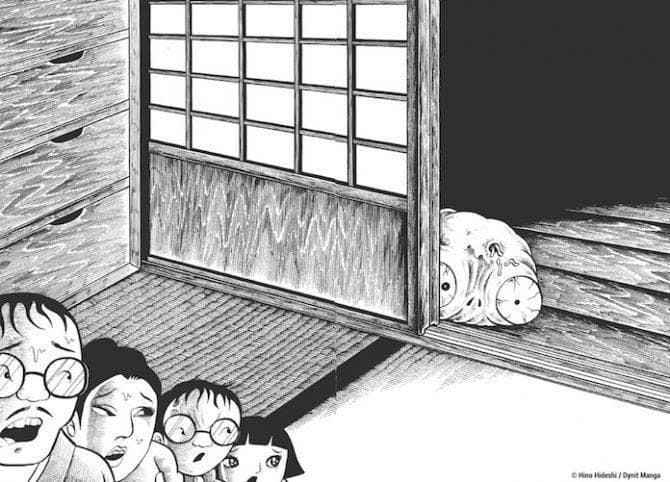

Though his work may not be in print anymore, the influence of Hideshi Hino knows no bounds. For true horror manga aficionados, you’ve heard his name through the grapevine – whether it’s the concentrated shotgun blast of the anthology Gallery Of Horrors or Hell Baby, Hino has no shortage of works siphoning through that wonderful mind of his. My personal favorite, Bug Boy, is a Kafka’s Metamorphosis type tale of a boy ostracized for his odd interests, bugs being the primary, of course. He passes on, and by a twist of fate is reincarnated as a bug himself. Hell Baby deals with another outcast of society, a baby thrown away by her father, left to grow up amongst the violent creatures of the garbage dump.
Throughout Hino’s work, you’re gonna see these doughy, moldable characters squish and bulge with goofy and terrifying expressions alike. He’s got this snappy, readable way of laying out a page with stark values and scratchy details so your eyes just chew through the pages, one after the other. Before you know it, the book’s over! Yet, despite the funny shapes of his characters and the silly faces abound, you’ll notice a commonality between them all. Each of Hino’s protagonists are outcasts, people on the fringes of society, scorned for their simple act of being, and eternal in their solitude. Though the big popping eyes and overall humor of the tales may distract you, be forewarned! There’s always a layer of sadness underpinning each of Hideshi Hino’s every tale. There’s always an overcoat of silliness to Hideshi Hino’s gore and grotesqueness, but is this merely a veil for sadder feelings? Oh, Hino…freaks deserve love, too!
Shigeru Mizuki (GeGeGe No Kitaro)
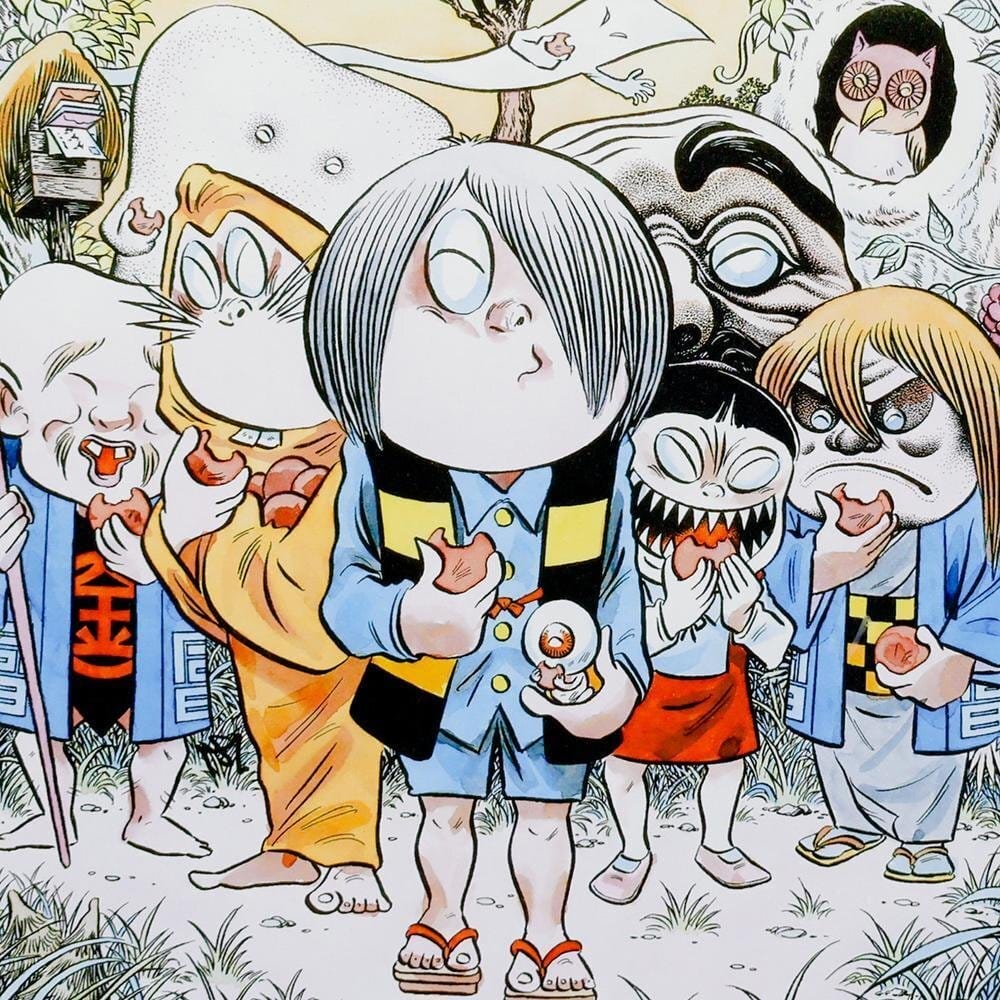

How can you get away with horror manga without mentioning one of its cornerstones? Shigeru Mizuki, powerhouse creator of GeGeGe No Kitaro, not only revived Japan’s interest in the supernatural yokai, but created a series that detailed each one’s intricate mythology, wrapping it all up in a horror-comedy bow. Kitaro, our lead, gets roped into story after story of these supernatural creatures, having to stop the violent spirits from getting out of hand and destroying the human world as we know it.
Can’t we all just get along?
Through various cleansing rituals and superpowers, Kitaro manages every time, and learns about creepy new creatures every chapter. Mizuki’s expressive character work details not only the myriad yokai, but Kitaro and crew, as precise linework and intricate backgrounds lend to a certainly unsettling setting. It doesn’t help that Mizuki crafts each story by slowly building up to the big reveal, making pages flips and double-page spreads all the more shocking when they drop by. It’s a must-read for horror manga fans who’ve just gotta know the roots of the genre.
Shintaro Kago (Super Dimensional Love Gun, Dimension 21)
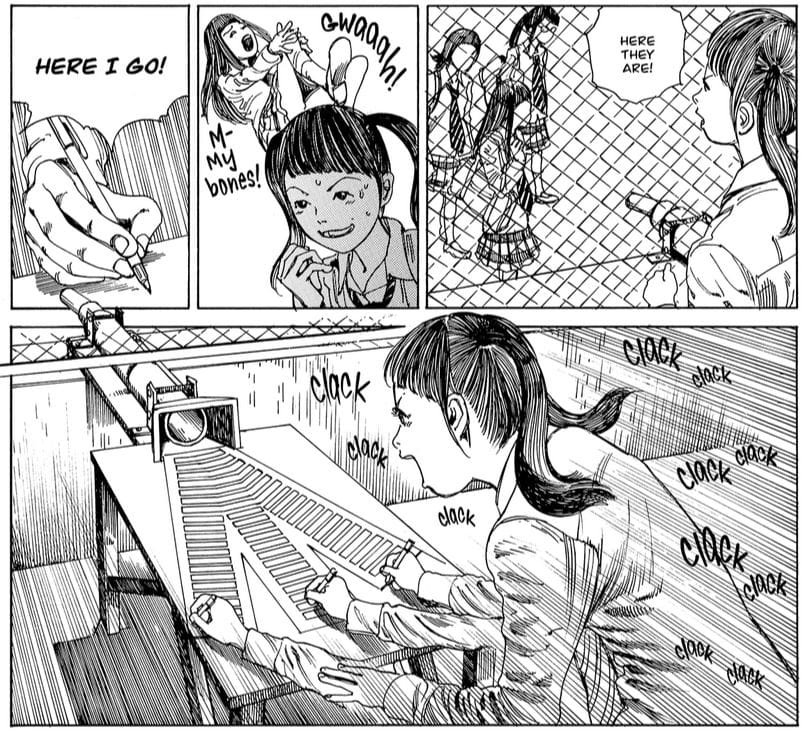

Puzzle piece mouths, white strings, and cannibalism, oh my! Shintaro Kago is best known for mind-splitting art pieces, and go figure, the guy who made such experimental pieces makes one hell of a manga. Super Dimensional Love Gun is a highly explicit, highly condensed short story anthology that feels like Kago’s freakiest ideas given fully detailed form. The way Kago arranges people and objects around the frame mirrors how fast the story must unfold in his mind. The white space in the panels drives a further sense of unease throughout the entire thing, and the angles, it seems like he never uses the same shot twice! Though Kago is less horror, and more ero guro, a genre focused around sexual corruption and eroticism (Silverberg), he still deserves a mention because of how he plays around with said erotic elements to create something truly shocking.
Even if it doesn’t scare you, per say, some of these stories can really put your hairs on end. In the least explicit story I can mention, the eponymous Super Dimensional Love Gun, a schoolgirl discovers that if she answers test questions fast enough, a small jet of air will shoot out in front of her. She takes this overly-specific superpower and begins experimenting with it: Stacking multiple test papers on top of the other, scribbling as fast as possible, and conjuring an even stronger, deadlier force ahead of her that can pierce glass. All to enact the ultimate revenge on the girls bullying her in increasingly intense ways. This ultimate revenge? Gory, brutal, and snappy. Yet, just like Hino, overlaid with broad brush strokes of dark humor.
The way Kago can evolve a singular concept like this and unfold it in such fascinating ways that makes Super Dimensional Love Gun an utterly vitriolic rollercoaster ride you can’t look away from. If you’re feeling extreme, Kago is the way to Ka-GO! (Pardon me.) Check out Dimension 21 and some of his myriad artbooks if Super Dimensional Love Gun tickles your fancy.
Masaaki Nakayama (PTSD Radio, Fuan No Tane)
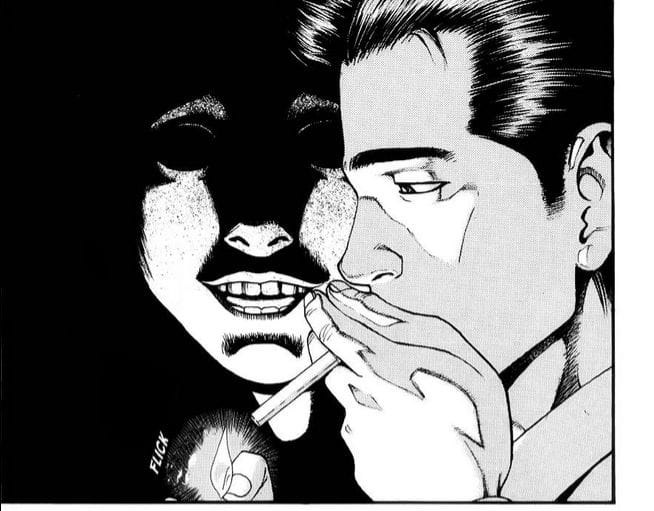

If you’re looking for someone in direct relation to Ito’s styling, look no further. Masaaki Nakayama’s your man, author of anthology manga PTSD Radio, threading together story after story of a haunted town. From strange apparitions with bursting eyes to twisted faces and beings not truly there, Nakayama’s got this amazing way of making a singular concept so condensed it could fit in your pocket. It’s good, then, that PTSD Radio is so widely distributed, because it’ll have you burning through page after page before you’ve even realized time’s passed. It’s a great way to spook yourself before bed.
Masaaki Nakayama’s very similar to Junji Ito in the way of building up tension, creating an atmosphere in which to surprise you with a shock twist; Nakayama lays out his panels in such a way that makes two-page spreads really pop, or he has you turn a page to reveal one messed-up looking creature. He does this even quicker than Ito does, which is his biggest strength, alongside fine-lined character artwork and stark attention to detail when it comes to said creatures, or shocked expressions. It’s one heck of a nightmare maker. His other anthology revolving around supernatural creatures is worth a read, too – Fuan No Tane. Same techniques employed in PTSD Radio, just a really fun, super quick read for all horror fanatics to enjoy.
Suehiro Maruo (The Strange Tale Of Panorama Island, Shojo Tsubaki)
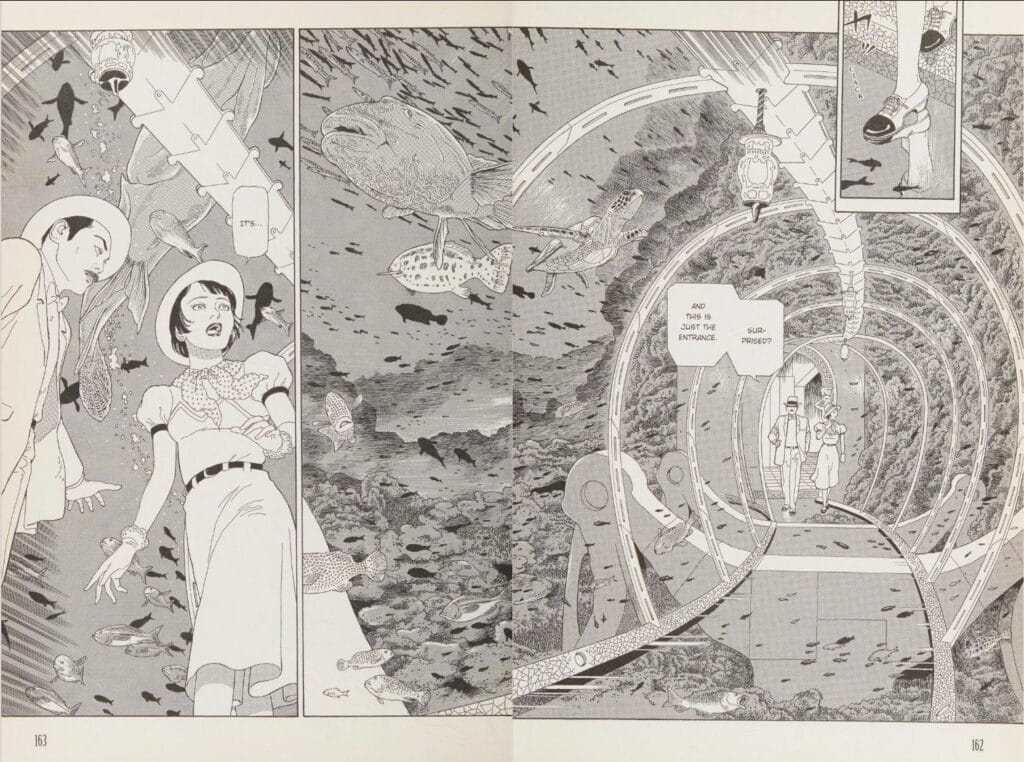

Hop around any bubble of the horror anime sphere, and you’ve probably heard of Suehiro Maruo. Though you may not recognize the nomenclature, he’s the creator of the infamous Midori: The Girl In The Freak Show (a.k.a. Shojo Tsubaki), a story of an unfortunate girl roped into a sleazy circus that’s a cornerstone of the ero guro world. Though famous for that, Maruo also made a slew of other works, my favorites being his Edogawa Rampo manga adaptations. The Japanese mystery writer extraordinaire, Rampo, was known not only for mind-bending mysteries, but also his eroticism, which made him a prime target for the like-minded Maruo to adapt.
The Strange Tale Of Panorama Island starts off with a case of stolen identity, as a twin brother steals his other brother’s identity and utilizes his brother’s funds to create the world of his dreams – the impossible Panorama Island, a place built for nothing but pleasure for pleasure’s sake! Chock full of optical illusions, nudity, and grandiose architecture, Suehiro Maruo renders it in peak form. Intricate blocking, careful lines, and sexual content lines these pages; The entire thing is so sharp, and the way it’s all paced from panel to panel makes it nothing short of an exhilarating read. It can only be compared to Tsutomu Nihei’s BLAME! – the egregious amount of detail on each and every page could take hours at a time to parse. Down and across the page, Suehiro Maruo crafts a world as gorgeous as it is disturbing, making it something you have to see to believe.
Kanako Inuki (Be Very Afraid Of Kanako Inuki!, School Zone, Presents )
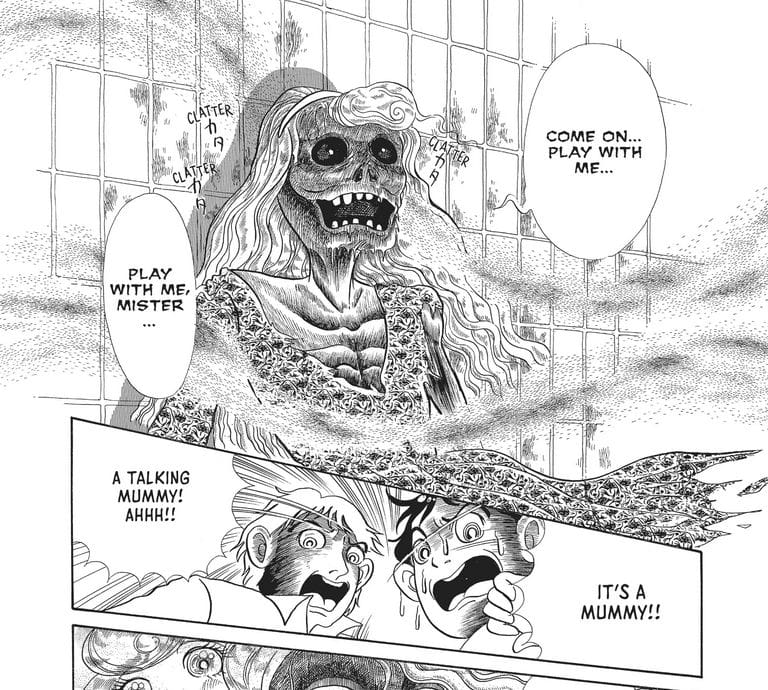

Also inspired by the late great Umezu, Kanako Inuki took pen to paper at a young age, and got to work on her own horror stories, full of all the things you know and love – voodoo dolls, mystery presents, and unexpected twists galore. Be Very Afraid Of Kanako Inuki! serves as a great introduction to her work, as each story is a tale told to its fullest in that good ol’ anthology style. The second story, Bukita-kun, features a girl who wants to grow up just a little too quickly, and suffers horrific consequences because of it.
Much like Hino, placing outcasts in precarious circumstances, Inuki takes a simple concept and lays it out over the page with such precision you can’t help but admire it. She’s got clear linework, bouncy expressions and spiralling eyes to her characters, which makes it all the better when the twist of that last couple pages come. Absolutely sure that as more of her work gets printed in English, she’s sure to be a heavy hitter like Umezu in her own right! But, for now, Be Very Afraid Of Kanako Inuki! is a great start.
Shuzo Oshimi (Blood On The Tracks, Flowers Of Evil)
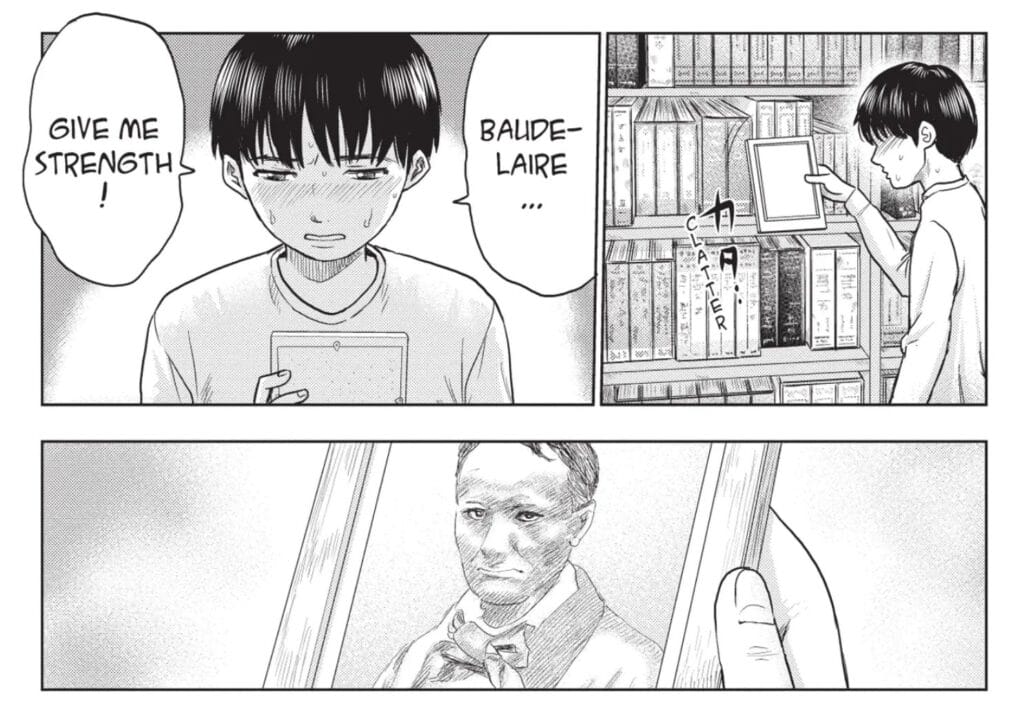

More psychological than horror outright, Shuzo Oshimi excels at uncomfortability above all else. Whether it’s the overprotectiveness of the mother in Blood On The Tracks or the manipulative nature of the bully in The Flowers Of Evil, he’s the master of putting his protagonists in difficult situations wherein they can’t escape, and instead are threaded through a series of events destroying their life bit by bit. There’s always an air of unease in each of Oshimi’s works that he crafts so well.
From page to page, there’s no clear standout panels, just small, short ones, until you notice each panel getting darker and darker, pulling closer and closer to each character’s face until a large explosion of a line, or a face, that can be described as nothing else but pure malice. The protagonists are beaten & bruised psychologically, mentally, and physically to a point where they’re unable to fight back against their oppressors, and the feeling of utter hopelessness and desperation created here with Oshimi’s works is something so, so hard to replicate. If you’re a fan of the more psychological stuff, look no further, Oshimi is your man.
In Conclusion
Many of my favorite artists listed here and elsewhere not only play with horror elements within their stories, but the compounding sense of loneliness and desperation that drives people to take certain actions, for better and for much, much worse. It’s one of my favorite things about the horror genre, a sense of shock and despair that you just can’t get in anything else.
I didn’t even get to newer publications of older manga, like Norikazu Kawashima’s Her Frankenstein , which follows a boy with a Frankenstein mask and his manipulative oppressor, or Franken Fran, a gag horror-comedy romp that’s sure to please. Though it may be easier to find your next battle anime than a horror title, hopefully one of these strikes your fancy, and you’ll go down a rabbit hole from which never you’ll return…In the best of ways, of course!
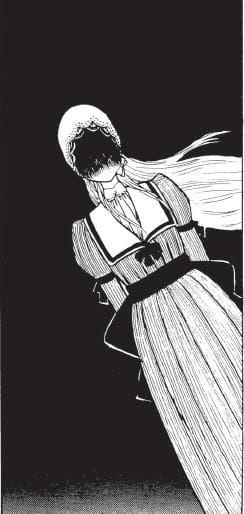

“And to all, a good night…”
Works Cited
Header image via Hell Baby, ©Hideshi Hino, Kosaido Publishing
